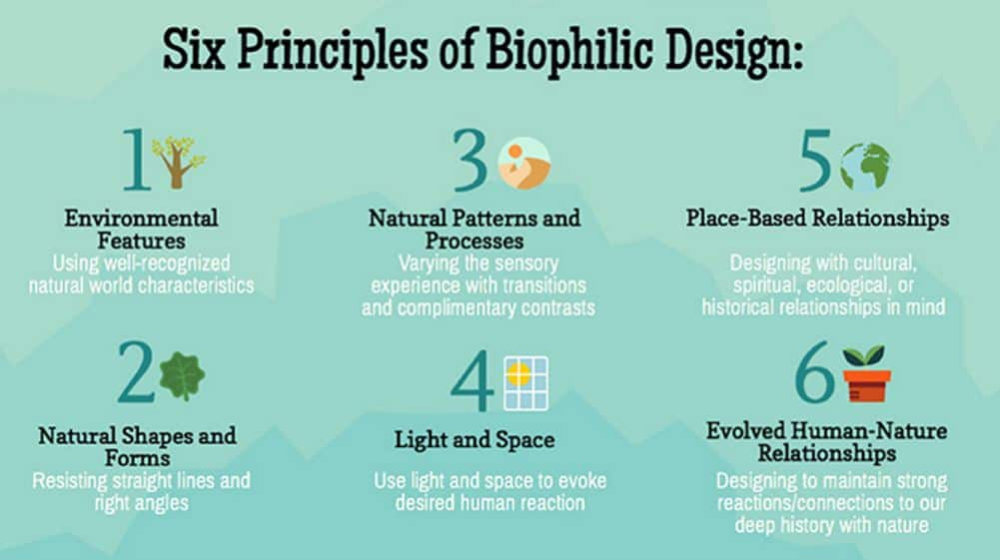Table Of Content

We have a visual preference for organic and biomorphic forms but the science behind why this is the case is not yet formulated. While our brain knows that biomorphic forms and patterns are not living things, we may describe them as symbolic representations of life (Vessel, 2012). The objective of the Connection with Natural Systems pattern is to heighten both awareness of natural properties and hopefully environmental stewardship of the ecosystems within which those properties prevail. In either case, the temporal component is usually the key factor in pattern recognition and the triggering of a deeper awareness of a functioning ecosystem.
Biophilic Home Design: A Beginner’s Guide to Nature-Inspired Living
We asked these and other leading designers and architects for the best ways to bring biophilia home. Before any major changes to your home, it’s important to plan ahead to ensure your project goes smoothly. The image you get of being told you’ve got cancer is, you know, sitting in front of the desk, you know, the doctor sitting in a chair.
Biophilic design: What is it? Why it matters? And how do we use it?

Biophilic design is still new, but more and moreprofessionals are versed in it. When assembling your team for a major homeremodel, look for architects and interior designers with LEED and WELL accreditations. They’ll have educationin environmentally friendly and sustainable practices that inherently tie intobiophilic design.
Direct experience of nature
This stringent selection is actually very important, because it frames the research to meet our specific goals and provides the necessary rigor to produce a substantive contribution to this early literature by revising it within this specific frame. The selected studies were localized in industrialized Western countries and typically of less than high methodological quality. Studies 8 and 9, showing the lowest level of reliability, proved not to contradict the high-quality studies but did not offer any further evidence to the synthesis, having no input into the design recommendations.
Other benefits of Refuge are suggested to include reduced irritation, fatigue and perceived vulnerability, as well as improved concentration, attention and perception of safety (Grahn & Stigsdotter, 2010; Wang & Taylor, 2006; Petherick, 2000; Ulrich et al., 1993). The objective of Biomorphic Forms & Patterns is to provide representational design elements within the built environment that allow users to make connections to nature. The intent is to use biomorphic forms and patterns in a way that creates a more visually preferred environment that enhances cognitive performance while helping reduce stress. Psychological responses encompass our adaptability, alertness, attention,concentration, and emotion and mood. This includes responses to nature thatimpact restoration and stress management. With the emergence of the green building movement in the early 1990s, linkages were made between improved environmental quality and worker productivity (7. Browning & Romm, 1994 ).
A Biophilic Home in Vietnam Impresses With a Hollow-Brick “Breathing Wall” - Living Architecture Monitor magazine
A Biophilic Home in Vietnam Impresses With a Hollow-Brick “Breathing Wall”.
Posted: Tue, 05 Dec 2023 08:00:00 GMT [source]
Khoo Teck Puat Hospital
Carbon dioxide is a greenhouse gas and one of the biggest culprits of climate change. By adding more plants and vegetation, we are taking carbon dioxide out of the atmosphere and reduce the carbon footprint of a building. Individuals who spend more time in nature tend to be more creative, compared to those working in offices with no sign of nature. When rooms are boring and lifeless, it can be difficult to come up with ideas for a new project.
When placed near the walls, for example, when the sound waves hit the walls, they are reflected into the vegetation. The reduction of noise pollution is a benefit of plants that is overlooked or more often than not, forgotten. When individuals are surrounded by plants, hear calming sounds from nature and have fresh air coming in, they feel calmer and more at ease. As opposed to listening to the traffic noise outside and looking at boring walls. Using our creativity, it’s possible to create sustainable buildings that connect us to nature, not divide us.
Mystery is the promise of more information achieved through partially obscured views or other sensory devices that entice the individual to travel deeper into the environment. A space with a good Refuge condition feels safe, providing a sense of retreat and withdrawal – for work, protection, rest or healing – whether alone or in small groups. A good refuge space feels separate or unique from its surrounding environment; its spatial characteristics can feel contemplative, embracing and protective, without unnecessarily disengaging. A space with a good Prospect condition feels open and freeing, yet imparts a sense of safety and control, particularly when alone or in unfamiliar environments. Natural materials can be decorative or functional, and are typically processed or extensively altered (e.g., wood plank, granite countertop) from their original ‘natural’ state, and while they may be extracted from nature, they are only analogous of the items in their ‘natural’ state.
Principles of Biophilic Building Design
Each sensory system has a vast body of research to support it; here we provide just a taste. Biophilic design can reduce stress, improve cognitive function and creativity, improve our well-being and expedite healing; as the world population continues to urbanize, these qualities are ever more important. A previous study by the authors focused on nonclinical therapeutic environments in the United Kingdom (Tekin et al., 2021, 2022), and identified other key biophilic design parameters, such as curiosity and sense of belonging, which were expected to be encountered in this review too. However, the discussed papers did not include any reference to them in the design of clinical environments. Lastly, a rigorous design framework should be benchmarked against objective scientific data and qualitative primary data about the impact of biophilic design on humans. This analysis of each of the biophilic design parameters is currently being researched by the authors through a thorough literature review and a mix of qualitative methods, which will provide a holistic discussion and further complement guidance.
Additionally, repeated viewing of real nature, unlike non-nature, does not significantly diminish the viewer’s level of interest over time (Biederman & Vessel, 2006). Alexander’s work built on the tradition of pattern books used by designers and builders from the eighteenth century onward, but his work focused on the psychological benefits of patterns and included descriptions of the three dimensional spatial experience, rather than the aesthetic focus of previous pattern books. These fourteen Patterns of Biophilic Design focus on psychological, physiological and cognitive benefits.
Both approaches can be utilized in tandem to enhance the biophilic experience. The organic and curvaceous stairs, mosaics, railings, light fixtures, window details and other decorative elements of the Hotel Tassel in Brussels, by Victor Horta are a classic example of Biomorphic Forms & Patterns. Nature abhors right angles and straight lines; the Golden Angle, which measures approximately 137.5 degrees, is the angle between successive florets in some flowers, while curves and angles of 120 degrees are frequently exhibited in other elements of nature (e.g., Thompson, 1917).
The JBD also publish Virtual Nature Walls as prints, wall art, large scale murals, landscape acoustic panels, video projections and high grade chemical resistant aluminium prints for NHS, ICU, Education, Workplaces, Homes. We aim to bridge the gap between research and practice of biophilic design and nature-based solutions through publishing and broadcasting international case studies, thought leadership and evidence to help mitigate and improve the Environmental, Health and Economic impact of design, build and construction. Using shapes and forms that are naturally found in nature is another important element used in biophilic design. These elements include columns, ovals, arches, shells, spirals, botanical motifs, biomimicry, etc. For example, in the kitchen illuminate with pendant lights, can lights, under-cabinet lighting, and standalone lamps for a full spectrum. But pay attention to light color, also called temperature, which is measured in 6500K, 4100K, and 2700K.
Even growing culinary herbs on your kitchen counter with a grow light offers a positive connection to nature. Considering the physical, mental, and emotional needs of people, interior designers use human-centered approaches to address how we live today. Creating novel approaches to promoting health, safety, and welfare, contemporary interiors are increasingly inspired by biophilia as a holistic approach to design. We have done an excellent job creating artificial lights that mimic natural light but nothing can quite beat the effect and feel of the sun. Letting natural light flood into buildings and cities is an easy way to create a more natural environment.
In addition, airflow will ensure variability in temperature which is yet another way to create a healthier environment within our living spaces. We should aim to do the same because it benefits both our productivity and focus. It will allow water to follow its natural cycle and won’t obstruct the natural flow of nutrients either. Other ways to develop sponge cities include adding natural flood barriers, forests, and parks. It is mainly found in architecture, interior design, and more recently in outdoor urban spaces. Having an awareness of a controllable risk can support positive experiences (Van den Berg & ter Heijne, 2005) that result in strong dopamine or pleasure responses (Kohno et al., 2013; Wang & Tsien, 2011; Zald et al., 2008).

No comments:
Post a Comment